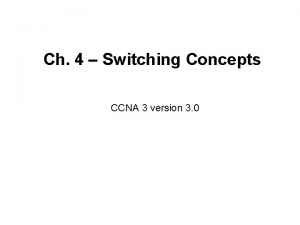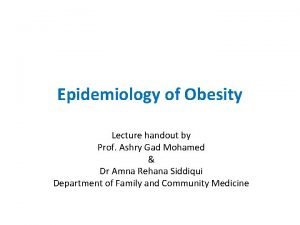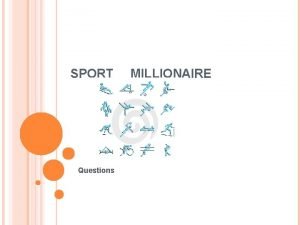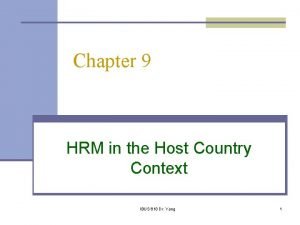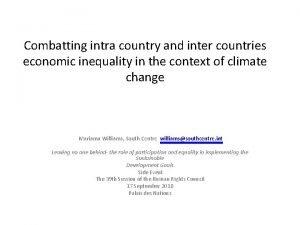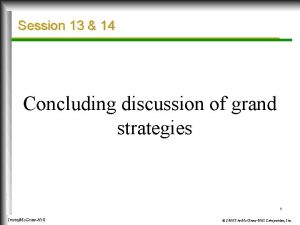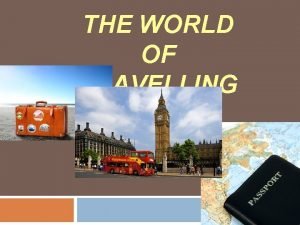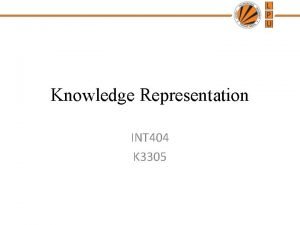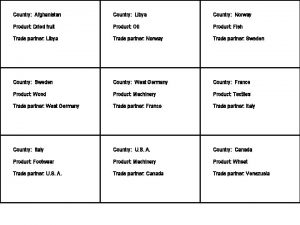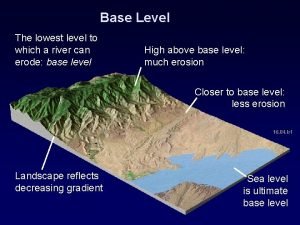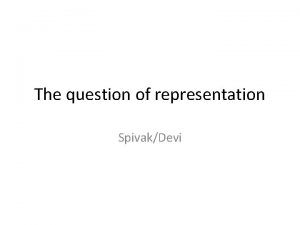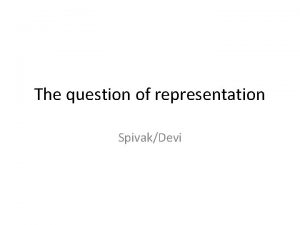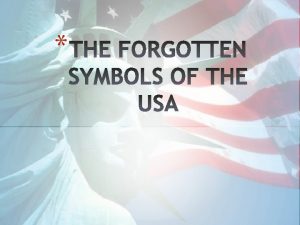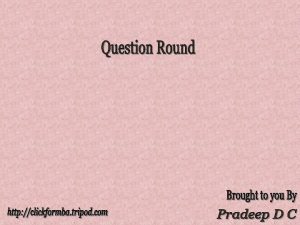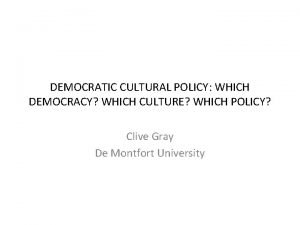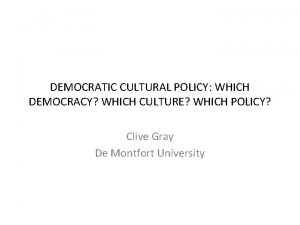Question 1 Representation Which country has the lowest

























- Slides: 25

Question 1: Representation Which country has the lowest representation for women in parliament – and which has the highest? (a) Rwanda (b) Ireland (c) Afghanistan (d) Ethiopia

Question 2: Voting Rights Women in this country only got full voting rights in 1990 [Hint: the country begins with the letter S…] S__________

Question 3: Health What is life expectancy in Ireland?

Question 4: Refuge and Migration People seeking asylum make up what percentage of the overall population of Ireland?

Question 5: Food True or False: There is enough food thrown out every day in ‘Developed’ countries to feed every hungry person in the world.

Question 6: Water According to the World Bank, it would cost $150 billion to provide clean water for everyone who needs it. Globally, how much do we spend on bottled water every year?

Question 7: Education Adult Literacy: What percentage of adults* in Ireland struggle with basic reading and writing? [* 16 - 65 year-olds]

Question 8: Trade What was the most valuable traded item in 15 th Century Timbuktu?

Hope you enjoyed these questions. Would you like to take a look at the answers? Remember, the point of the quiz isn’t to get the most correct answers. It actually doesn’t matter if none of the answers were correct. The point is to think about what these questions, and our answers to them, say to us about our picture of the world.

Question 1: Representation Which country has the lowest representation for women in parliament – and which has the highest? (a) Rwanda (b) Ireland (c) Afghanistan (d) Ethiopia

Photo: Sam Ngendahimana / worldbank. org 1. Lowest Level of Representation for Women in Parliament: (d) Ireland (24%) has the lowest representation for women in parliament of these five countries. Rwanda (67. 5%) has the highest, followed by Ethiopia (39%) and Afghanistan (28%). Sources: http: //data. worldbank. org/indicator/SG. GEN. PARL. ZS https: //ec. europa. eu/eurostat/databrowser/view/sdg_05_50/default/table? lang=en

Question 2: Voting Rights Women in this country only got full voting rights in 1990 [Hint: the country begins with the letter S…] S__________

2. In which country did women get full voting rights in 1990? Switzerland Women in Switzerland only got full voting rights throughout the country in 1990. Following a referendum, women gained the right to vote in general elections in 1971. 34% of the all-male electorate voted against equality. It was the second referendum on the question. However, some districts held out and did not allow women to vote in regional elections until a legal challenge in 1989. Finally, following a legal challenge, full suffrage was achieved in 1990.

Question 3: Health What is life expectancy in Ireland?

3. Life expectancy in Ireland? Answer: Depends whose lives we’re talking about. Average life expectancy in Ireland is 80. 5 years. But whose lives are we talking about? For Traveller men it is 61, and 70 for Traveller women. The suicide rate for Travellers is 6 times the national average. Traveller infants aged under two are 10 times more likely to die from SIDS (Sudden Infant Death Syndrome) or congenital diseases than in the settled community. In Ireland the mean age of death for a homeless woman is 38, and 44 for men. People who are homeless have an average life span of 42. Sierra Leone has the lowest life expectancy in the world, at 52. 7 (2019)

Question 4: Refuge and Migration People seeking asylum make up what percentage of the overall population of Ireland?

4. People seeking asylum make up approximately 0. 15% of the overall population of Ireland. As of May 2020 there were about 7, 700 people living in Direct Provision = 0. 15% of the overall population. Direct Provision is the controversial system of accommodation for people seeking asylum in Ireland, providing for basic needs and a small allowance. There are numerous restrictions placed on people (including the right to work, to study, to drive and to make decisions about everyday life). People are sometimes forced to live in DP for many years while waiting for a decision on their application for International Protection.

Question 5: Food True or False: There is enough food thrown out every day in ‘Developed’ countries to feed every hungry person in the world.

5: Food Waste True – three times over. The ‘Developed World’ throws out three times enough food every day to feed every hungry person in the world. Consumers in ‘Developed’ countries throw away 222 metric tonnes of food a year – the equivalent of the entire production of Sub Saharan Africa. www. irishtimes. com/news/environment/the-battle-against-food-waste-1. 3425288

Question 6: Water According to the World Bank, it would cost $150 billion to provide clean water for everyone who needs it. Globally, how much do we spend on bottled water every year?

6. Global spending on bottled water every year? $300 billion. World Bank estimate of providing clean water for all: $150 billion. Annual global revenue from bottle water: over $300 billion. The UN also estimates that 1, 800 children under the age of 5 die every day for lack of access to clean water.

Question 7: Education Adult Literacy: What percentage of adults* in Ireland struggle with basic reading and writing? [* 16 - 65 year-olds]

Question 7: 18% of adults struggle with basic reading and writing. The global average literacy level is 86%. In Ireland 18% of 16 -65 year olds are at Level 1 or below in a 5 -Level Literacy scale. That’s 521, 550 people. Only 65, 000 are getting support. 25% of adults in Ireland struggle with basic numeracy, and 55% have low digital skills. (NALA 2020) www. thejournal. ie/irish-adults-literacy-5156484 -Jul 2020/

Question 8: Trade What was the most valuable traded item in 15 th Century Timbuktu?

8. The most valuable traded item in 15 th century Timbuktu: Books Timbuktu was founded in the 5 th century. By the 15 th and 16 th centuries Timbuktu was an important centre for Islamic culture. One of the earliest Universities in the world was founded in Sankore, Timbuktu. At its height, the universities had over 25, 000 students (in a city with a population of 100, 000) and a library holding between 400, 000 - 700, 000 manuscripts
 Introduction to waves
Introduction to waves Which wave has the lowest frequency
Which wave has the lowest frequency Which element has the largest atomic radius
Which element has the largest atomic radius Which switching method has the lowest level of latency?
Which switching method has the lowest level of latency? Asia pacific bmi
Asia pacific bmi Level questions
Level questions Disadvantages of wireframe modelling
Disadvantages of wireframe modelling Olypmpic sports
Olypmpic sports Host country and home country
Host country and home country Intra country vs inter country
Intra country vs inter country Model of grand strategy clusters
Model of grand strategy clusters Every nation and every country
Every nation and every country Every country has their own traditions
Every country has their own traditions Every country has its
Every country has its Question words present simple
Question words present simple Advantages and disadvantages of probing questions
Advantages and disadvantages of probing questions Contoh open-ended question
Contoh open-ended question What do you call the factor-naming questions?
What do you call the factor-naming questions? Direct questions into indirect questions
Direct questions into indirect questions Difference between compelling and supporting questions
Difference between compelling and supporting questions Example of compelling question
Example of compelling question Which is not a property of representation of knowledge?
Which is not a property of representation of knowledge? What instrument is this
What instrument is this Lowest energy state
Lowest energy state Differences between mechanical and electromagnetic waves
Differences between mechanical and electromagnetic waves Lowest trophic level
Lowest trophic level



